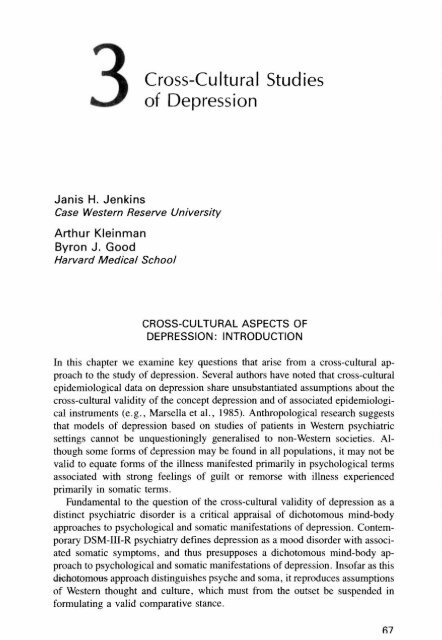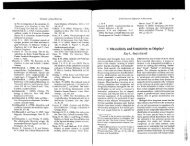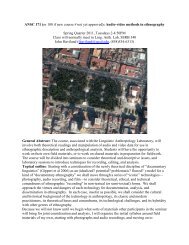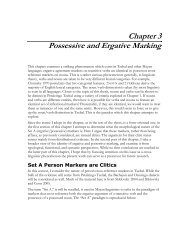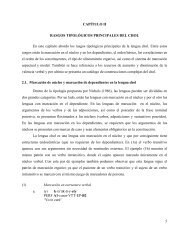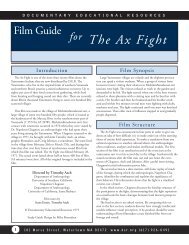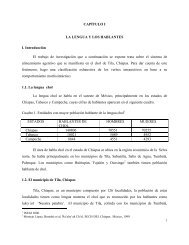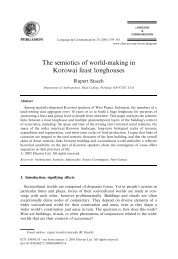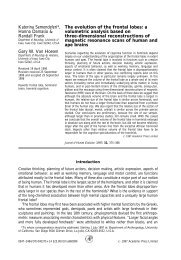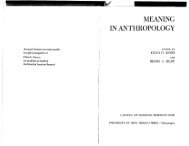Cross-Cultural Aspects of Depression - Anthropology
Cross-Cultural Aspects of Depression - Anthropology
Cross-Cultural Aspects of Depression - Anthropology
You also want an ePaper? Increase the reach of your titles
YUMPU automatically turns print PDFs into web optimized ePapers that Google loves.
3 <strong>Cross</strong>-<strong>Cultural</strong><br />
Janis H. Jenkins<br />
Case Western Reserve University<br />
Arthur Kleinman<br />
Byron J. Good<br />
Harvard Medical School<br />
Studies<br />
<strong>of</strong> <strong>Depression</strong><br />
CROSS-CULTURAL ASPECTS OF<br />
DEPRESSION: INTRODUCTION<br />
In this chapter we examine key questions that arise from a cross-cultural approach<br />
to the study <strong>of</strong> depression. Several authors have noted that cross-cultural<br />
epidemiological data on depression share unsubstantiated assumptions about the<br />
cross-cultural validity <strong>of</strong> the concept depression and <strong>of</strong> associated epidemiological<br />
instruments (e.g., Marsella et al., 1985). Anthropological research suggests<br />
that models <strong>of</strong> depression based on studies <strong>of</strong> patients in Western psychiatric<br />
settings cannot be unquestioningly generalised to non-Western societies. Although<br />
some forms <strong>of</strong> depression may be found in all populations, it may not be<br />
valid to equate forms <strong>of</strong> the illness manifested primarily in psychological terms<br />
associated with strong feelings <strong>of</strong> guilt or remorse with illness experienced<br />
primarily in somatic terms.<br />
Fundamental to the question <strong>of</strong> the cross-cultural validity <strong>of</strong> depression as a<br />
distinct psychiatric disorder is a critical appraisal <strong>of</strong> dichotomous mind-body<br />
approaches to psychological and somatic manifestations <strong>of</strong> depression. Contemporary<br />
DSM-III-R psychiatry defines depression as a mood disorder with associated<br />
somatic symptoms, and thus presupposes a dichotomous mind-body approach<br />
to psychological and somatic manifestations <strong>of</strong> depression. Ins<strong>of</strong>ar as this<br />
di
68 JENKINS, KLEINMAN, AND GOOD<br />
Our review begins with consideration <strong>of</strong> cultural variation in dysphoric affect<br />
and the import <strong>of</strong> such variation for universalist definitions <strong>of</strong> depressive disorder.<br />
We examine cross-cultural evidence on somatic components <strong>of</strong> depression<br />
and explore the concept <strong>of</strong> somatization in relation to depression and the communication<br />
<strong>of</strong> distress. In the second part <strong>of</strong> our discussion, we review the evidence<br />
<strong>of</strong> cross-cultural variation in depressive symptomatology (Marsella et al., 1985).<br />
Observation <strong>of</strong> striking cultural and social class variations in symptoms is frequently<br />
used to support the view that culture affects the content but not the<br />
process or structure <strong>of</strong> psychopathology. We argue that culture is <strong>of</strong> pr<strong>of</strong>ound<br />
importance to the experience <strong>of</strong> depression, the construction <strong>of</strong> meaning and<br />
social response to depressive illness within families and communities, the course<br />
and outcome <strong>of</strong> the disorder, and thus to the very constitution <strong>of</strong> depressive<br />
illness. This anthropological perspective is presented through examination <strong>of</strong> a<br />
series <strong>of</strong> theoretical, substantive, and methodological issues. In particular, we<br />
review the social and cultural contexts within which depression originates, examining<br />
the role <strong>of</strong> gender, social class, family relations, migration, political violence,<br />
and social change. Finally, we suggest directions for future research .<br />
..<br />
THE CULTURAL CONSTRUCTION OF EMOTION<br />
Although the cross-cultural study <strong>of</strong> depression and depressive affect invariably<br />
presupposes a theory <strong>of</strong> emotion, it is by no means certain that emotions are<br />
constituted the same way in different cultures. We begin this section by briefly<br />
summarising an anthropological perspective on emotion, and then set forth issues<br />
central to the cross-cultural study <strong>of</strong> depression: ( 1) the ethnopsychology <strong>of</strong><br />
emotion; and (2) culturally distinctive meanings associated with dysphoric<br />
emotions.<br />
To the extent that emotions have been considered shared or common experiences<br />
<strong>of</strong> individuals across culturally distinct settings, they have generally been<br />
assumed similar on the basis <strong>of</strong> universal, innate human propensities (Ekman,<br />
1982; Isard, 1977; Plutchik, 1980; Wierzbicka, 1986). If culture is acknowledged<br />
as a factor in emotional life, it is only as a second-order interpretation <strong>of</strong><br />
such innate qualities (Levy, 1984). In addition, thought and emotion are cast as<br />
largely separate, mutually exclusive categories: "the cultural/ideational and individual/<br />
affective have been construed as theoretically, and empirically, at odds"<br />
(Rosaldo, 1984, p. 139). Against this common scholarly assumption we argue<br />
here for an approach to emotion as an essentially cultural integration <strong>of</strong> bodily<br />
experience and communication.<br />
Given the (empirically unproven) assumption <strong>of</strong> biological similarity <strong>of</strong> emotional<br />
states, we need to consider cultural sources <strong>of</strong> similarity and variation.<br />
This point has been advanced by Geertz (1973), who asserted that "not only<br />
ideas, but emotions too, are cultural artifacts" (p. 81). Emotions can be consid-
70 JENKINS, KLEINMAN, AND GOOD<br />
others. While these characterizations <strong>of</strong> the self index general differences in<br />
broad cultural axes, it is important to note that as generalizations they oversimplify<br />
the construction <strong>of</strong> the self, failing to specify particular domains and<br />
settings across which selves may be differentially constituted within a culture.<br />
An understanding <strong>of</strong> emotions as intrapsychic events, feelings or introspections<br />
<strong>of</strong> the individual is a specifically Western definition. A case contrast to<br />
emotion as introspective feeling state has recently been provided by Lutz ( 1985,<br />
1988) in her studies <strong>of</strong> the Ifaluk <strong>of</strong> Micronesia. For the Haluk, cultural categories<br />
<strong>of</strong> thought and emotion are not strongly differentiated. Moreover, emotions<br />
are not located within persons, but in relationships between persons or within<br />
events and situations. Metagu (fear/anxiety), for example, is said to occur in<br />
response to a superior's justifiable song (anger) over the breach <strong>of</strong> a cultural<br />
taboo, the situation <strong>of</strong> being in an open canoe in shark-infested waters or the<br />
occurrence <strong>of</strong> ghost activity. (It is important to note, however, that emotion, for<br />
the Ifaluk is sometimes experienced and defined as "about our insides.") Dysphoria<br />
or depression may thus be experienced as a predominantly intra-psychic<br />
mood disorder <strong>of</strong> individuals in more social and contextual terms (Toussignant,<br />
1984). ..<br />
Differing cultural interpretations <strong>of</strong> self and emotion may therefore lead to one<br />
<strong>of</strong> the most important aspects <strong>of</strong> emotional life: variations in the qualitative<br />
features <strong>of</strong> bodily/emotional experience. Dysphoric affects cannot properly be<br />
considered as basically " the same " cross-culturally: there are culturally distinctive<br />
repertoires <strong>of</strong> distressing experience. For example, Ebigbo (I 982, p. 29)<br />
found that "Mentally ill patients in Nigeria and indeed in West Africa very <strong>of</strong>ten<br />
complain <strong>of</strong> various types <strong>of</strong> somatic distress. These complaints are made independently<br />
<strong>of</strong> the diagnosis <strong>of</strong> the mental illness and whether or not it is very<br />
acute. Examples <strong>of</strong> such psychosomatic complaints are: heat in the head, crawling<br />
sensation <strong>of</strong> worms and ants, headache, heaviness sensation in the head,<br />
biting sensation all over the body, etc." Among a Mexican-descent population,<br />
Jenkins (1988a, 1988b) found that indigenously labeled conditions <strong>of</strong> nervios<br />
incorporate a variety <strong>of</strong> somatic complaints, including "brainache," or the sensation<br />
that the brain is "exploding" or " uncontrollable." These complaints stand in<br />
stark contrast to those commonly recognized among European and North American<br />
populations.<br />
Emotion states not only vary in relation to self-concept, they are also elaborated<br />
in light <strong>of</strong> cultural knowledge. Entire domains <strong>of</strong> emotional life may be<br />
either culturally and experientially elaborated or unelaborated. This has been<br />
particularly documented for the emotion <strong>of</strong> anger. For example, while the<br />
Eskimos (Briggs, 1970) virtually never display anger, the Kaluli <strong>of</strong> New Guinea<br />
(Schieffelin , 1983) and the Yanomarno <strong>of</strong> Brazil (Chagnon, 1977) have highly<br />
elaborated, culturally sanctioned displays <strong>of</strong> anger. Among the Tahitians studied<br />
by Levy (I 973), an important societal rule is the inhibition <strong>of</strong> anger. According<br />
to Levy these Society Islanders in fact seldom experience anger (Levy, 1973).
3. CROSS-CULTURAL STUDIES OF DEPRESSION 71<br />
This is no less true <strong>of</strong> appropriate displays <strong>of</strong> pr<strong>of</strong>ound sadness and sorrow, some<br />
cultures encourage such expressions (for example, Iranian culture) while others<br />
evidence little tolerance <strong>of</strong> these affects . Furthermore, within a culture, social<br />
class influences how particular emotions are communicated. Chinese villagers<br />
may express sadness publicly, but middle class, formally educated Chinese will<br />
not do so outside <strong>of</strong> close family relations. In addition to fundamental differences<br />
in cultural emphases on particular emotions, such states may also vary in affective<br />
intensity and meaning. Some societies (e.g., Amazonian Yanomamo) may<br />
foster intense emotional involvement, whereas others (e.g., the Javanese) may<br />
encourage inner states <strong>of</strong> "smoothness" and calm (Chagnon, 1977; Geertz,<br />
1973).<br />
<strong>Cross</strong>-cultural studies <strong>of</strong> the socialization <strong>of</strong> affect have documented that<br />
differences in emotional emphases are deeply rooted in the developmental makeup<br />
<strong>of</strong> cultural members (Ochs & Schieffelin, 1985). As noted by H. Geertz<br />
(1959), socialization <strong>of</strong> affect selects for a cultural repertoire or "vocabulary <strong>of</strong><br />
emotion":<br />
Every cultural system includes patterned ideas regarding certain interpersonal relationship<br />
and certain affective states, which represent a selection from the entire<br />
potential range <strong>of</strong> interpersonal and emotional experiences. The child, growing up<br />
within the culture and gradually internalizing these premises, undergoes a process<br />
<strong>of</strong> socially guided emotional specialization. He learns, in a sense, a special vocabulary<br />
<strong>of</strong> emotion. ( p. 225)<br />
<strong>Cultural</strong> specialization in emotional life again raises the possibility <strong>of</strong> whether<br />
emotions, unknown to us, are part <strong>of</strong> the everyday experience <strong>of</strong> members <strong>of</strong><br />
culturally distinct societies.<br />
A common assumption is that depression can be conceived on a continuum, as<br />
mood, symptom, or disorder (see Kleinman & Good, 1985). That there is a clear<br />
cut<strong>of</strong>f point between normal dysphoria and pathological depression has never<br />
been definitively demonstrated for our own culture. There is even less empirical<br />
reason to believe that it is identical across cultures. Partly for this reason, indigenous<br />
concepts <strong>of</strong> dysphoric affect cannot be so neatly partitioned from psychiatric<br />
definitions <strong>of</strong> depressive disorder.<br />
CULTURE AND DEPRESSIVE AFFECT<br />
Dysphoria-sadness, hopelessness, unhappiness, lack <strong>of</strong> pleasure with the<br />
things <strong>of</strong> the world and with social relationships-has dramatically different<br />
meaning and form <strong>of</strong> expression in different societies (Kleinman & Good, 1985,<br />
p. 3). The suffering <strong>of</strong> individuals appears against the background <strong>of</strong> cultural<br />
images <strong>of</strong> suffering. Gaines and Farmer (1986) review the cultural system <strong>of</strong>
72 JENKINS, KLEINMAN, AND GOOD<br />
meaning that identifies individuals who suffer as exemplary heroes in Mediterranean<br />
culture. Obeyesekere ( 1985) points out that suffering is a permanent<br />
positively valued feature <strong>of</strong> cosmology in Buddhist cultures. Good, Good, and<br />
Moradi ( 1985) demonstrate that suffering is a highly elaborated religious element<br />
associated with martyrdom and grief for Shi'ite Muslins. Tousignant (1984) and<br />
Jenkins ( l988b) show that suffering is associated with a culturally pr<strong>of</strong>ound<br />
sense <strong>of</strong> tragedy in Latin American cultures.<br />
Different cultural traditions <strong>of</strong> suffering vary according to the salience <strong>of</strong> the<br />
" vocabulary <strong>of</strong> emotion" (Geertz, 1959), that is, whether notions <strong>of</strong> suffering are<br />
elaborated or unelaborated; expressed in secular or religious idioms; culturally<br />
valued or disvalued; relevant to the individual self or to broader social and<br />
historical contexts. While some cultures have no specific word for depression per<br />
se (Marsella, 1980), absence <strong>of</strong> a word or concept for an emotion does not<br />
preclude its presence. For example, some emotions may elude culture or be so<br />
deeply unconscious that they are not easily conceived or known (Obeyesekere,<br />
1985). The cultural elaboration <strong>of</strong> depression may influence standards <strong>of</strong> individual<br />
social functioning in the face <strong>of</strong> suffering, where some may experience<br />
relatively higher ievels <strong>of</strong> suffering and still perform occupational or interpersonal<br />
roles.<br />
In the absence <strong>of</strong> a cultural concept <strong>of</strong> depression, depressive states can be<br />
studied as a feature <strong>of</strong> local forms <strong>of</strong> suffering. Indeed, some authors have<br />
documented a fundamental and pervasive "ethos <strong>of</strong> suffering" that permeates<br />
nearly every aspect <strong>of</strong> world view. "In highland Ecuador, pena refers to a state <strong>of</strong><br />
mind characterized by a mixture <strong>of</strong> sadness and anxiety as well as to an illness<br />
state resembling depression . . . the ideology in which it is embedded serves to<br />
interpret a bodily problem at the same time as it reflects a more global attitude<br />
toward life ... When misfortune abounds in the Sierra <strong>of</strong> Ecuador, life becomes<br />
a litany <strong>of</strong> penas, or sorrows" (Tousignant, 1984, p. 381 ). The ideology <strong>of</strong> pena,<br />
as with other Latin American attitudes toward suffering, cannot correctly be<br />
interpreted as a fatalistic resignation or submission; rather, it represents a cultural<br />
tradition <strong>of</strong> the recognition and existential working through <strong>of</strong> oppressive life<br />
circumstances.<br />
From his ethnographic analysis <strong>of</strong> depressive moods in Sri Lanka, Obeyesekere<br />
(1985) elaborated an analytic conception <strong>of</strong> "the work <strong>of</strong> culture" to<br />
explain "the process whereby painful motives and affects such as those occurring<br />
in depression are transformed into publicly accepted sets <strong>of</strong> meanings and symbols"<br />
(Obeyesekere, 1985, p. 147). The cultural perception <strong>of</strong> chronic and pervasive<br />
suffering is expectable for any typical Buddhist. That one recognizes and<br />
accepts the inevitable condition <strong>of</strong> suffering is the first step toward the spiritual<br />
abandonment <strong>of</strong> suffering. Although suffering occupies a prominent part <strong>of</strong> life<br />
experience, it is nonetheless expected that a lay person take pleasure in everyday<br />
life. Suffering is , then, not an all-encompassing aspect <strong>of</strong> life in the sense <strong>of</strong> an<br />
ethos. Even so, Buddhist laymen may "generalize their despair from the self to
3. CROSS-CULTURAL STUDIES OF DEPRESSION 73<br />
the world at large and give it Buddhist meaning and significance" (Obeyesekere,<br />
1985 , p. 140).<br />
The foregoing examples from Latin America and Sri Lanka provide a sharp<br />
contrast with an Anglo-American ethos concerning suffering. In the latter context,<br />
suffering is not an expectable or acceptable state <strong>of</strong> affairs. Rather, it is<br />
something to overcome through personal striving, volition, and the "pursuit <strong>of</strong><br />
happiness." A strong contrast in willingness to endure suffering was observed by<br />
Jenkins (1988a), in her comparisons <strong>of</strong> Mexican-descent and Caucasion American<br />
families who were living with a family member afflicted with schizophrenic<br />
illness. Mexican families displayed more willingness to endure suffering associated<br />
with the problem and expressed sadness more frequently and pr<strong>of</strong>oundly<br />
than Caucasion Americans who more commonly voiced anger and frustration<br />
(Jenkins et al., I 986; Karno et al., 1987).<br />
Empirical investigations <strong>of</strong> indigenous conceptions <strong>of</strong> depression-as symptom,<br />
mood, or syndrome-have been rare. A notable exception is the study by<br />
Manson, Shore , and Bloom (1985) <strong>of</strong> depression among the Hopi <strong>of</strong> the Southwestern<br />
United States. The authors documented five discrete depressive conditions<br />
recognized by the Hopi: worry sickness, unhappiness, heartbroken, drunken-like<br />
craziness (with or without alcohol), and disappointment-pouting. "Each<br />
<strong>of</strong> these categories <strong>of</strong> illness is associated with a cluster <strong>of</strong> cognitive, affective ,<br />
and behavioral states" (p. 337). However, for the Hopi symptoms which would<br />
be subsumed under the single psychiatric diagnostic category <strong>of</strong> depression are<br />
parsed out among different illnesses, each with its characteristic etiology and<br />
treatment. The importance <strong>of</strong> examining the clinical relevance <strong>of</strong> such cultural<br />
differences in categories <strong>of</strong> illnesses has yet to be appreciated (Edgerton, 1966;<br />
Jenkins, 1988; Marsella, 1980; White, 1982).<br />
SOMATIZATION AND DEPRESSION<br />
Where standard criteria and diagnostic interviews <strong>of</strong> clinical depression (ICD-9<br />
and DSM-III) are systematically used together, the prevalence rates <strong>of</strong> depression<br />
are found to vary greatly across cultures. For example, findings range from 4.6 to<br />
6.5% in the North American Epidemiological Catchment Area studies (Myers et<br />
al., 1984; Robins et al., 1984) to .15 to 3.3% in various studies in India (Rao,<br />
1973). Among the highest rates in the world are those reported for Africa: 14.3%<br />
for men and 22.6% for women in Orley and Wing's (1979) Uganda research. But<br />
these rates also disclose a particularly salient cross-cultural similarity: Most cases<br />
<strong>of</strong> depression world-wide are experienced and expressed in bodily terms <strong>of</strong><br />
aching backs, headaches, constipation, fatigue and a wide assortment <strong>of</strong> other<br />
somatic symptoms that lead patients to regard this condition as a physical problem<br />
for which they seek out primary care assistance from general practitioners<br />
(be they traditional or cosmopolitan). Only in the contemporary West is depres-
74 JENKINS, KLEINMAN, AND GOOD<br />
sion articulated principally as an intrapsychic experience (e.g., "I feel blue"),<br />
and even in the West most cases <strong>of</strong> depression are still lived and coped with as<br />
physical conditions (e.g., "my back aches"). The term applied to this phenomenon<br />
is somatisation: the expression <strong>of</strong> interpersonal and personal distresse.g.,<br />
frustration, despair, major depressive disorder-in an idiom <strong>of</strong> bodily<br />
complaints (Kleinman, 1986, 1988a). Kirmayer (1985) shows that whether<br />
somatization is a sociolinguistic or psychophysiological process, or both, remains<br />
unclear. The practical significance <strong>of</strong> somatization for cross-cultural studies<br />
<strong>of</strong> depression is that the models <strong>of</strong> depression based on studies <strong>of</strong> inpatients<br />
and outpatients in Western psychiatric settings tend to emphasize a picture <strong>of</strong><br />
depression that is not the main one in non-Western societies (where the vast<br />
majority <strong>of</strong> the world's population and most <strong>of</strong> the depressed live). In many<br />
societies and subcultures, rules <strong>of</strong> politeness, absence <strong>of</strong> psychological linguistic<br />
terms, expression <strong>of</strong> emotion in nonverbal modes or in formal aesthetic forms<br />
such as poetry, and understanding <strong>of</strong> depression as a bodily experience lead to<br />
symptom pictures that may include little or no psychologically minded expression<br />
<strong>of</strong> dysphoria.<br />
For this reasort, depression may not be diagnosed, and DSM-III and ICD-9<br />
categories, if used in the strict sense without an appreciation for subtlety and<br />
metaphor, may lack validity in non-Western settings or among certain ethnic<br />
populations. The forms <strong>of</strong> somatization show local cultural patterns, with neurasthenic<br />
patterns <strong>of</strong> complain common in East and South Asia and becoming<br />
popular again in the West under the rubric <strong>of</strong> chronic fatigue syndrome. Heart<br />
distress in Iran (Good, 1977), dizziness in China (Kleinman, 1986; Ots, 1990),<br />
gastrointestinal complaints among Cambodian and Vietnamese refugees in North<br />
America, physical sensations <strong>of</strong> the loss <strong>of</strong> soul or vital essence in a number <strong>of</strong><br />
societies (Shweder, 1985), are examples <strong>of</strong> local illness idioms, final common<br />
pathways that express distress and disorder <strong>of</strong> many types, including depression<br />
(see Carr & Vitaliano, 1985). Somatization in the non-Western world, moreover,<br />
is not infrequently associated with parasitic infections, anemia owing to malnutrition,<br />
and other intercurrent physiological pathologies so that the bodily<br />
idiom <strong>of</strong> distress has a ready-made physiological basis, and one that also contributes<br />
to the onset <strong>of</strong> depression. Indeed, this is also a significant problem for<br />
diagnosis (Weiss & Kleinman, 1987), inasmuch as the symptoms <strong>of</strong> many medical<br />
disorders (e.g., anorexia, sleep disturbance, reduced energy, motor retardation)<br />
overlap with the vegetative complaints <strong>of</strong> depression, rendering diagnosis<br />
uncertain.<br />
Somatization may also shape the course and outcome <strong>of</strong> depressive disorder.<br />
Where somatization rates are highest, guilt, low self-esteem and suicide<br />
tend to be less frequent (see Kleinman's 1988a review <strong>of</strong> this issue, pp. 42-45).<br />
On the other hand, somatization <strong>of</strong> major depressive disorder has routinely been<br />
found to delay effective treatment for depressive disorders and to contribute
3. CROSS-CULTURAL STUDIES OF DEPRESSION 75<br />
to minimal utilization <strong>of</strong> outpatient and in-patient services (Katon, Kleinman,<br />
& Rosen, 1982). Anecdotal reports from clinicians suggest that somatization <strong>of</strong><br />
depression may "protect" depressed patients from morbid preoccupation with<br />
emotional states and thus reduces the likelihood <strong>of</strong> depression becoming a<br />
way <strong>of</strong> life. To the best <strong>of</strong> our knowledge this potentially significant proposition<br />
has never been investigated. We tum our attention now to cross-cultural examination<br />
<strong>of</strong> social factors and the onset <strong>of</strong> depression. Most prominent among<br />
these are gender, social class, family relations, refugee/migrant status, and social<br />
change.<br />
GENDER AND DEPRESSION<br />
An overwhelming number <strong>of</strong> Western studies <strong>of</strong> depressive disorder report a<br />
significantly higher rate <strong>of</strong> depression among women than men (Blazer et al.,<br />
1985; Craig & VanNatta, 1979; Howell & Bayes, 1981; Redl<strong>of</strong>f, 1985; Weissman<br />
& Myers, 1978). In a critical review <strong>of</strong> these studies, Weissman and Klerman<br />
( 1981) conclude that socially inculcated gender differences in susceptibility<br />
to depression are real, that is, not based on endocrinological or genetic factors,<br />
differences in helpseeking or affective expression, or methodological artifact. For<br />
Western societies, they cite the <strong>of</strong>ten-quoted evidence showing greater depression<br />
among married females (vs. married males) as illustrative <strong>of</strong> the conflicts<br />
generated by the traditional female role ( 1981: 184 ). The classic study <strong>of</strong> Braverman<br />
et al. (1970) documenting a strong gender differentiation in clinicians'<br />
mental health ideals has frequently been cited as evidence <strong>of</strong> the inherent conflicts<br />
posed by sex -role stereotypes in the United States (Braverman et al., 1970,<br />
p. 322). For example, healthy women are said to differ from healthy men by<br />
being more submissive, less independent, more emotional, and so forth.<br />
Recent epidemiological evidence from the multi-site NIMH Epidemiological<br />
Catchment Area (ECA) studies confirms gender differences in the prevalence <strong>of</strong><br />
affective disorders within the United States. From the cities <strong>of</strong> Baltimore, New<br />
Haven, and St. Louis, Robins and associates (1984) reported disorders that most<br />
clearly predominated in men were antisocial personality and alcohol abuse.<br />
Disorders that most clearly predominated in women were depressive episodes<br />
and phobias. This finding was true <strong>of</strong> all three East Coast ECA sites.<br />
Further evidence <strong>of</strong> female psychiatric vulnerability comes from the work <strong>of</strong><br />
Brown and Harris (1978), who found that depression was extremely common<br />
among London working class women. In addition, they identified a set <strong>of</strong> specific<br />
vulnerability factors characteristic <strong>of</strong> the life circumstances <strong>of</strong> depressed women.<br />
These include lack <strong>of</strong> employment outside the home; absence <strong>of</strong> an intimate<br />
or confiding relationship with a husband/boyfriend; three or more small children<br />
in the home; and loss <strong>of</strong> mother prior to age eleven. Howell and Bayes (1981)
76 JENKINS, KLEINMAN, AND GOOD<br />
formulate a similar set <strong>of</strong> risk factors, including lack <strong>of</strong> outside employment, the<br />
presence <strong>of</strong> young children, being employed in addition to household and childcare<br />
responsibilities (resulting in fatigue), family moves that follow the husband's<br />
employment and result in her own unemployment and/or social isolation.<br />
Indeed, " because <strong>of</strong> the particular constellation <strong>of</strong> environmental circumstances<br />
that rather universally characterizes married women in this culture, we are <strong>of</strong>ten<br />
to some extent diagnosing a situation rather than a person when we diagnose a<br />
woman as depressed" (Howell, 1981 , pp. 154-155, italics in original).<br />
Weissman and Klennan (1981) report that "The evidence in support <strong>of</strong> these<br />
[gender] differential rates is best established in Western industrial societies.<br />
Further studies in non-Western countries ... are necessary before any conclusions<br />
can be drawn as to the universality <strong>of</strong> this differential rate" (p. 184).<br />
Although much more research is needed to map out cultural dimensions <strong>of</strong> the<br />
role <strong>of</strong> gender in predisposing individuals to depression, these authors appear to<br />
have been unaware <strong>of</strong> a small but suggestive anthropological literature from<br />
which hypotheses can be drawn.<br />
For Africa, the most important early work was conducted by M. J. Field.<br />
Based on her sttl'dy <strong>of</strong> Ghanaians seeking help at healing shrines, she reported<br />
that "depression is the commonest mental illness <strong>of</strong> Akan rural women" (1960,<br />
p. 149). Women who have recourse to the healing shrines tend to be <strong>of</strong> an age at<br />
which they should be reaping the benefits and social prestige customarily accorded<br />
to senior wives, but in many cases their positions have been undermined<br />
by their husbands' introduction <strong>of</strong> younger wives into the household. A common<br />
presenting complaint <strong>of</strong> these women is self-accusation <strong>of</strong> witchcraft. Among the<br />
Akan, witchcraft is a detested and highly stigmatized behavior; thus self-accusation<br />
indicates extremely low levels <strong>of</strong> self-esteem and self-worth.<br />
Abbott and Klein (1979) also document depression as more common among<br />
rural Kikuyu women than men in Kenya, linking it with women's low status and<br />
concomitant powerlessness. In this culture, residence is patrilocal, and land is<br />
predominantly owned and controlled by the patrilineage. "<strong>Cultural</strong> beliefs and<br />
values regarding women generally devalue them, characterizing them as less<br />
intelligent than men, as rightly under the domination <strong>of</strong> men, and as belonging<br />
only to the home, the domestic space. Women are to defer to men" ( 1979, p.<br />
181). In addition, two thirds <strong>of</strong> the men have left the community to seek wage<br />
labor in cities and towns, leaving women with the burden <strong>of</strong> horticultural labor<br />
and family responsibility ( 1979, p. 164 ). Abbott and Klein find that the least<br />
modernized women are at the greatest risk for depression, seeming to belie the<br />
common notion that modem urban life is more conducive to mental disorder than<br />
traditional rural life. However, we would suggest that in a region so much under<br />
the hegemonic sway <strong>of</strong> wage labor economy that two thirds <strong>of</strong> the men are<br />
absent, the self-definition <strong>of</strong> women may have been sociohistorically recast as<br />
"backward," hence reinforcing their subordinate status.
3. CROSS-CULTURAL STUDIES OF DEPRESSION 77<br />
More recently, Mitchell and Abbott ( 1987) reported on the patterning <strong>of</strong><br />
symptoms <strong>of</strong> depression and anxiety among Kikuyu secondary school students.<br />
The authors found significant gender differences in the responses revealing<br />
that females reported more depressive symptoms than males. While the extent<br />
<strong>of</strong> the gender differences in depression was not as great as in the earlier study<br />
by Abbott and Klein (1979), they are nonetheless consistent in showing a greater<br />
female preponderance <strong>of</strong> depression. This finding was also recently reported<br />
in Kenya by Ndetei and Vadher (1982). The observation that depression is an<br />
extremely common disorder among African women has been supported by Orley<br />
and Wing (1979), who found higher rates among Ugandan female villagers<br />
than among working class women in London. Orley and Wing documented depressive<br />
disorder among 14.3% <strong>of</strong> male Ugandan villages and 22 .6% <strong>of</strong> female<br />
villagers.<br />
Ullrich (1987) observed depression to be extremely common among Havik<br />
Brahmin women in a south Indian village. Ullrich argues that the traditional<br />
cultural ideal <strong>of</strong> women predisposes them to depression . Indeed, Beck's triad <strong>of</strong><br />
negative self-image, negative interpretation <strong>of</strong> life events, and negative view <strong>of</strong><br />
the future is regarded as the cultural ideal for older women. Additional factors<br />
that may lead to depression among women in this setting include early marriage<br />
age (an associated loss <strong>of</strong> contact with close kin), poor marital relationships, and<br />
the perception <strong>of</strong> helplessness. With cultural changes and an increase in marriage<br />
age, educational level, and decision-making, however, it now appears that this<br />
cultural bias against women is no longer fully sanctioned in this contemporary<br />
Indian village.<br />
A striking age-related finding in the study by Kamo and colleagues (1987)<br />
identifies the group most vulnerable to depression as young (18-39 years-<strong>of</strong>-age)<br />
non-Hispanic White women: over 15% <strong>of</strong> this subgroup had suffered major<br />
depression. Such age-specific vulnerabilities to depression have been noted elsewhere<br />
(Hirshfeld & <strong>Cross</strong>, 1982). These younger age cohort <strong>of</strong> Caucasian American<br />
women in the ECA study suffer disproportionately from major depression<br />
relative to men in either ethnic group or women <strong>of</strong> Mexican-descent. These<br />
findings are particularly alarming, and as noted by the authors, require further<br />
explication. Such results sound a cautionary note against simplistic reasoning<br />
concerning presumed cumulative effects <strong>of</strong> ethnicity, socioeconomic status, and<br />
gender in the absence <strong>of</strong> sociodemographic data on age. The importance <strong>of</strong> agespecific<br />
data is further borne out by Kamo and colleagues' (1987) findings that<br />
dysthymia was most prevalent (9.4%) among older women ( +40 years <strong>of</strong> age) <strong>of</strong><br />
Mexican descent. Although the Puerto-Rican study did not provide age-specific<br />
data, dysthymia was also noted to be highly prevalent among women (7 .6%)<br />
relative to men (1. 6%) (Canino et a!., in press-b).<br />
These age-related findings also raise the question <strong>of</strong> the relationship <strong>of</strong> traditional<br />
female roles and vulnerability to depression. Prudo, Harris, and Brown
78 JENKINS. KLEINMAN, AND GOOD<br />
( 1984) found that the types <strong>of</strong> severe life events associated with depression varied<br />
with the degree <strong>of</strong> integration into traditional society. As among African women<br />
(Abbott & Klein, 1979; Field, 1960), Hispanic women have been identified as a<br />
population at high risk for the development <strong>of</strong> depressive disorders (Mendes de<br />
Leon, 1988; Richman, 1987; Torres-Matrullo, 1982; Vegaet a!., 1984; Zavalla,<br />
1984). In the United States, this group has been considered particularly vulnerable<br />
by virtue <strong>of</strong> gender and ethnic minority status, and <strong>of</strong>ten, lower socioeconomic<br />
status as well (Mirande & Enriquez, 1979; Zavalla, 1984). From<br />
Los Angeles, a cross-cultural component <strong>of</strong> the Epidemiological Catchment Area<br />
survey (Kamo et a!. , 1987) was designed to include Mexican-descent populations.<br />
Major depressive episodes showed:<br />
a surprising ethnicity effect among women, with non-Hispanic white women under<br />
40 years <strong>of</strong> age showing 2.5 times the rate <strong>of</strong> Mexican-American women. These<br />
differences disappear in those over the age <strong>of</strong> 40. A strong trend is present for<br />
greater prevalence <strong>of</strong> total affective disorders on the part <strong>of</strong> young non-Hispanic<br />
white women compared with young Mexican-American women. Dysthymia shows<br />
a trend toward,. greater prevalence among Mexican women over 40 compared with<br />
their non-Hispanic white counterparts. (p. 699)<br />
Recent lifetime prevalence data from epidemiological studies utilizing the<br />
Diagnostic Interview Schedule (DIS) confirm a gender vulnerability (Canino et<br />
a!., in press-b; Karno et al., 1987). Among a Puerto Rican sample, Canino et al.<br />
(in press-b) found significantly higher depression and dysthymia among women.<br />
Gonzales (I 978) found that Puerto Rican women who had been diagnosed as<br />
neurotic or depressive and were receiving treatment had sex-role orientations<br />
significantly more traditional than did comparison (normal healthy) housewives<br />
and students. Torres-Matrullo (1982) found a high incidence <strong>of</strong> symptoms <strong>of</strong><br />
dependence among nonacculturated mainland Puerto Rican women. "Feelings <strong>of</strong><br />
inferiority, low-self-esteem, psychosomatic complaints, and premature marriages<br />
and parenthood among Hispanic women have been regarded as resulting from the<br />
traditional female role" (Canino , 1982, p. 123). However, empirical research is<br />
necessary for a more sophisticated understanding <strong>of</strong> gender roles in Hispanic<br />
culture, since characterizations <strong>of</strong> women in the current literature are overly<br />
simplistic:<br />
It is questionable whether most functional Hispanic traditional women are as subjugated,<br />
passive, and dependent on the male as the literature depicts them to be. But<br />
the question still remains as to how can we explain the higher incidence <strong>of</strong> psychopathology<br />
found among traditional Hispanic women . Is it that the role per se<br />
induces psychopathology? Or is it that dysfunction occurs more <strong>of</strong>ten when the<br />
woman is in a societal and family context where the traditional role is not valued,<br />
but on the contrary, is maladaptive and conflictive? (Canino, 1982, p. 124)
3. CROSS-CULTURAL STUDIES OF DEPRESSION 79<br />
In light <strong>of</strong> the foregoing cross-cultural studies, we can advance the hypothesis<br />
that epidemiological studies in the Third World will reveal a disparity between<br />
female and male rates <strong>of</strong> depression broadly similar to that documented in Westem<br />
societies. This hypothesis is lent credence by the nearly universal structural<br />
subordination <strong>of</strong> women cross-culturally (Collier, 1987; Farnham, 1987; Lamphere,<br />
1987; Rosaldo & Lamphere, 1974; Sanday, 1981). Nonetheless, overall<br />
rates are likely to vary for women relative to local factors such as child socialization<br />
practices, variations in control over resources , marriage patterns, and cultural<br />
ideology and value orientations surrounding gender relations. Moreover, there<br />
are exceptions. In one epidemiological survey. Carstairs and Kapur (1976) found<br />
a higher rate <strong>of</strong> depression among men than women in a rural region <strong>of</strong> southwestern<br />
India. However, in that matrilineal society there is considerable social<br />
dislocation due to newly legislated patrilineal inheritance patterns.<br />
SOCIOECONOMIC STATUS AND DEPRESSION<br />
Hirshfeld and <strong>Cross</strong> ( 1982) recently summarized the relationship <strong>of</strong> social class<br />
to depressive disorders in Western settings: "Whether defined by occupational,<br />
income, or educational level or a combination <strong>of</strong> these, there is strong evidence<br />
that rates <strong>of</strong> depressive symptoms are significantly higher in persons <strong>of</strong> lower<br />
SES than in persons <strong>of</strong> higher social class" (p. 39). Indeed, this association has<br />
been similarly reported by numerous investigators (e.g., Craig & Van Natta,<br />
1979; Radi<strong>of</strong>f, 1985; Weissman & Boyd, 1983). However, rates <strong>of</strong> unipolar<br />
depressive disorder have also been found to be exceptionally high among upper<br />
SES pr<strong>of</strong>essional women (Weiner, Marten, & Wochnick, 1977). Reviewing<br />
lifetime prevalence <strong>of</strong> depression in a community survey, Weissman & Myers<br />
( 1978) similarly reported a vulnerability to depression among the upper social<br />
classes.<br />
Studies <strong>of</strong> general psychiatric disability and unemployment have typically<br />
shown a strong relationship between economic conditions and admissions to<br />
treatment. Brenner ( 1973) conducted a survey <strong>of</strong> psychiatric hospitalizations in<br />
the United States between 1914 and 1967 to show that economic downturns were<br />
associated with increased rates <strong>of</strong> hospitalization. In an extensive review <strong>of</strong><br />
research on schizophrenia and economic conditions, Warner (1985) cites evidence<br />
<strong>of</strong> the higher prevalence <strong>of</strong> schizophrenia found in lower social classes,<br />
except during times <strong>of</strong> full employment. He noted that outcomes, such as the<br />
degree <strong>of</strong> impairment in social functioning, are linked to the type <strong>of</strong> economic<br />
structures within social groups. During periods <strong>of</strong> unemployment in wage labor<br />
economies, for example, recovery is poor relative to patient outcomes within<br />
agrarian peasant societies. 1n light <strong>of</strong> current epidemiological data, similar hypotheses<br />
could also be advanced for depressive disorders.
80<br />
JENKINS, KLEINMAN, AND GOOD<br />
As noted before, in London, England, Brown and Harris (1978) found that<br />
working class women had a rate <strong>of</strong> depression four times higher than middleclass<br />
women. Working class women were likely to suffer a depressive episode in<br />
the year prior to research contact if they had certain vulnerability factors (e.g.,<br />
lack <strong>of</strong> a close confiding relationship with a husband/boyfriend; unemployment)<br />
and had experienced a severe life event (e.g. , death in the family). Findings such<br />
as these raise the obvious question <strong>of</strong> whether qualitatively different life conditions<br />
may engender vulnerability to depressive disorders, and thereby account for<br />
the association between SES and depression.<br />
Brown and Harris ( 1978) lay the groundwork for empirical investigation <strong>of</strong><br />
this issue by elaborating research methods to document life events and life<br />
difficulties. They begin with the caveat that there is ". . . nothing to suggest<br />
there is any difference in the appraisal <strong>of</strong> adversity in the differing social classes<br />
in Camberwell . . . working-class women simply have more" (p. 191). (Similar<br />
observations about the cumulative and "objective" effects <strong>of</strong> oppressive life<br />
circumstances among the poor have been reported by other investigators [Hirschfeld<br />
& <strong>Cross</strong> 1982]). In addition, because their material conditions are more<br />
tenuous than thetr middle-class counterparts, they suffer more in response to loss<br />
or disappointment. Brown and Harris pinpoint the subgroup <strong>of</strong> lower SES women<br />
with children living at home as experiencing the greatest number <strong>of</strong> severe life<br />
events. Examples <strong>of</strong> such events include learning that a husband has cancer,<br />
losing a job at short notice, son killed while at play, evicted by landlord, being<br />
forced to have an unwanted abortion because <strong>of</strong> poor housing conditions, overdose<br />
taken by schoolage daughter. For chronic depressive conditions, the higher<br />
rates <strong>of</strong> depression for working class women hold across all life stages, and are<br />
not restricted to those with children living at home.<br />
This work suggests that attention to adverse life events may contribute a<br />
valuable element <strong>of</strong> specificity to broad-based findings about social class and<br />
vulnerability to depression. Studies which have begun to follow this lead include<br />
a comparison <strong>of</strong> depressed and normal controls in Kenya that found significantly<br />
more life events among depressed patients in the 12 months preceding onset<br />
(Vahder & Nedetei, 198 1 ). In an independent line <strong>of</strong> research Paykel ( 1978) has<br />
also documented the precipitation <strong>of</strong> clinical depression by stressful life events.<br />
Brown and hi s colleagues have continued to increase the specificity <strong>of</strong> the relation<br />
between particular types <strong>of</strong> severe life events and characteristics <strong>of</strong> women at<br />
risk (Brown, Bifulco, & Harris, 1987; for a methodological critique <strong>of</strong> Brown's<br />
earlier work see Tennant & Bebbington, 1978).<br />
Consistent with the approach adopted by meaning-centered medical anthropology<br />
(Good & Good, 1982) is the finding that the most important aspect <strong>of</strong><br />
life events is the meaning attributed to specific and cumulatively distressing life<br />
circumstances. Rather than the impact <strong>of</strong> change per se being deleterious to one's<br />
mental health, it is the personally incorporated cultural meanings <strong>of</strong> those events<br />
that appears to be <strong>of</strong> crucial importance (Brown, 1974; Brown & Harris, 1978;
3. CROSS-CULTURAL STUDIES OF DEPRESSION 81<br />
Day eta!., 1987). Moreover, social supports have routinely been shown to be less<br />
available and more fragile for lower socioeconomic persons. Inasmuch as this<br />
feature <strong>of</strong> the social environment also predicts for depressive onset, comparative<br />
studies <strong>of</strong> the meaning <strong>of</strong> supports would seem to be another avenue for future<br />
cross-cultural research. From the anthropological standpoint, stressors and supports<br />
are systematically bound together within local social systems. These systems<br />
may protect individuals (and categories <strong>of</strong> individuals) from major social<br />
pressures or may render them particularly vulnerable to forces <strong>of</strong> deprivation,<br />
oppression, or loss (Kleinman, (1986), forces which can create local vicious<br />
cycles <strong>of</strong> demoralization and defeat. The anthropological perspective calls for a<br />
different methodology for measuring stress and support, one that takes into<br />
account the ethnographic description <strong>of</strong> the changing social contexts within<br />
which events are perceived, experienced, and managed.<br />
Relatively scant attention, on the whole, has been allotted to the question <strong>of</strong><br />
socioeconomic status and depression cross-culturally. This is in part due to the<br />
difficulty <strong>of</strong> obtaining valid indicators <strong>of</strong> social stratification and class variation ,<br />
on the one hand, and the paucity <strong>of</strong> cross-cultural studies on depression , on the<br />
other. However, these studies consistently report that the least educated have<br />
higher depression scores (e.g., Abbott & Klein, 1979; Vega et al., 1984; Zavalla,<br />
1984). Moreover, the other major component <strong>of</strong> social class, employment, is also<br />
linked to depressive illness (Dressler, 1986; Ndetei & Vadher, 1982). Dressler<br />
and Badger (1986) found that among Blacks in the southern United States unemployment<br />
was significantly related to higher depressive symptomatology, independent<br />
<strong>of</strong> other demographic factors or stressful life circumstances. These findings<br />
support the general conclusion that unemployment engenders a substantial<br />
risk for the development <strong>of</strong> depression.<br />
DEPRESSION AMONG REFUGEES AND IMMIGRANTS<br />
Recently, there has been a proliferation <strong>of</strong> studies <strong>of</strong> the relation between political<br />
exile and depressive disorders. Depressive illness is apparently quite common<br />
among Southeast Asian refugees (Beiser, 1985; DeLay & Faust, 1987). In a<br />
survey <strong>of</strong> 97 Hmong adult refugees in the U.S., Westermeyer ( 1988) found a<br />
very high rate <strong>of</strong> psychiatric and social disorder that included major depressive<br />
illness. A group that was found to be particularly vulnerable to depression was<br />
unmarried Laotian and Vietnamese refugees, who showed high levels <strong>of</strong> depression<br />
in the l-12 months following their arrival. Other investigators have also<br />
found depression to be extremely common among Vietnamese refugees in primary<br />
clinic settings.<br />
In an Indochinese clinic population in the United States, many <strong>of</strong> the patients<br />
had concurrent diagnoses <strong>of</strong> major affective disorders, posttraumatic stress disorder,<br />
and medical and social disabilities resultant from a history <strong>of</strong> trauma and
82 JENKINS, KLEINMAN, AND GOOD<br />
torture (Mollica, Wyshak, & Lavelle, 1987, p. 1567). The most vulnerable<br />
subgroup identified by these investigators was unmarried women. These women,<br />
typically the victims <strong>of</strong> rape and torture in the natal countries, suffered the most<br />
severe psychiatric and social impairment.<br />
A protective factor identified for Indochinese refugees in the U.S. is living<br />
arrangements with families <strong>of</strong> similar cultural background: refugees in these<br />
settings were found to be significantly less depressed and had better school<br />
performance than those who lived in foster homes with Caucasian families or in<br />
group homes. Beiser (1988) investigated the issue <strong>of</strong> whether resettlement in<br />
Canada is associated with an increased risk for depression among Southeast<br />
Asian refugees, and found that better mental health was enjoyed by refugees the<br />
longer they remained in Canada. Length <strong>of</strong> time after displacement was also<br />
found to be associated with decreased symptom levels in a study <strong>of</strong> Iranian<br />
immigrants to the United States (Good, Good, & Moradi, 1985).<br />
In Africa, the prevalence <strong>of</strong> depressive symptomatology among Namibian<br />
refugees residing in a sub-Saharan host country was quite high (Shisana &<br />
Celentano, 1985). These authors also found that social support helped to ameliorate<br />
the effects o"f chronic stress, as represented by the length <strong>of</strong> time in exile, but<br />
that depressive symptomatology was to be understood as directly associated with<br />
difficulties incurred by the problems posed by the stressors <strong>of</strong> adaptation and<br />
acculturation.<br />
Vega et a!. ( 1986) conducted a large survey <strong>of</strong> immigrant Mexican women in<br />
southern California. Using the Center for Epidemiological Studies <strong>Depression</strong><br />
checklist (CES-D), they determined that there was an inverse association between<br />
CES-D scores and number <strong>of</strong> years in the United States. <strong>Depression</strong> has<br />
also been reported as extremely common among Mexican immigrants in Northem<br />
California, and has been linked to the difficulties associated with living<br />
conditions that include racism, unemployment, crowded and unsanitary living<br />
situations, and nondocumented legal status (Ring & Munoz, 1987).<br />
In a study <strong>of</strong> Iranian immigrants to the United States Good, Good, and Moradi<br />
(1985) document the interplay <strong>of</strong> cultural themes, sociopolitical events, and<br />
depressive disorder. Iranians interpret and communicate depressive symptoms in<br />
relation to elements already thematized in Iranian culture: sadness and grief are<br />
essential qualities <strong>of</strong> life elaborated in Shi'ite religious culture and popular literature,<br />
insecurity and mistrust are common interpersonal themes especially with<br />
regard to interpersonal relations and marital fidelity; uncontrolled anger is a<br />
culturally marked and stigmatized sign <strong>of</strong> depression; and emotional "sensitivity"<br />
acquired through early childhood experience is a common personality<br />
self-attribution. The experience <strong>of</strong> depression consequent to political deracination<br />
is shaped by these four cultural themes.<br />
A factor analytic study <strong>of</strong> psychiatric symptom levels assessed with the Brief<br />
Symptom Index (BSI) in a nonclinical population <strong>of</strong> Jewish Iranian women<br />
immigrants suggested the presence <strong>of</strong> a distinctly Iranian depressive syndrome,
3. CROSS-CULTURAL STUDIES OF DEPRESSION 83<br />
the symptoms <strong>of</strong> which cross-cut the pre-established categories <strong>of</strong> the Westernbased<br />
epidemiological instrument. Based on cross-sectional analysis, reported<br />
symptom levels peak at 2 years postmigration and decline thereafter, a time<br />
frame which the authors suggest is typical <strong>of</strong> a grieving process and indicates that<br />
the culturally elaborated grieving process remains intact for these immigrants.<br />
Among types <strong>of</strong> losses reported, including loss <strong>of</strong> wealth, home, and one's "very<br />
life," the lowest symptom levels were found among those emphasizing loss <strong>of</strong><br />
friends. In line with their association <strong>of</strong> the grieving process with adjustment to<br />
the immigrant experience, Good, Good, and Moradi (1985, p. 413) suggest that<br />
"the ability to have and to mourn the loss <strong>of</strong> close friendships is a mark <strong>of</strong> a<br />
healthier immigrant" (see also Good & Good, 1988). However, longitudinal<br />
studies are necessary to separate adaptation processes from cohort effects.<br />
Research is only now becoming available on depression among political refugees<br />
from Central America (Williams, 1987), especially El Salvador and Guatemala<br />
(Guamaccia & Farias, 1988; Jenkins, 1989), and much more attention will<br />
need to be paid to this topic as these groups continue to enter the United States.<br />
In the clinical/research experience <strong>of</strong> the first author (JJ) and her Latino colleagues<br />
from a specialty Latino clinic in a Boston area hospital, depression, among<br />
other psychiatric disorders (e.g.,dysthymia, panic disorders and posttraumatic<br />
stress syndromes) is very frequent, and is apparently due to the after effects <strong>of</strong> political<br />
violence and inhospitallife conditions in American urban settings. While<br />
forced uprooting and difficulties <strong>of</strong> acculturation are sources <strong>of</strong> distress, political<br />
oppression and turmoil also clearly have an effect independent <strong>of</strong> migration.<br />
DEPRESSION AND FAMILY FACTORS<br />
While the influence <strong>of</strong> early developmental experience for subsequent onset <strong>of</strong><br />
depression has long been presumed in psychoanalytic circles (e.g., Arieti, 1959;<br />
Robertson, 1979), empirical evidence for Western or cross-cultural examination<br />
<strong>of</strong> such theories has been lacking. In a recent review Campbell (1986, p. 4 7)<br />
notes the surprising paucity <strong>of</strong> research on the family and depressive disorders.<br />
Nonetheless, there have been hypotheses concerning the etiology <strong>of</strong> depression<br />
in relation to cultural variations in socialization practices and family structure.<br />
Several family contextual factors have been examined, including number <strong>of</strong><br />
primary caretakers (for presumed minimization <strong>of</strong> child frustration), family cohesiveness<br />
and extended networks, values orientations, and self-structures (Engelsman,<br />
1982). Eaton and Weil (1955) have linked family cohesiveness and<br />
patriarchal structure to rates <strong>of</strong> depression.<br />
In a recent study by Weissman and colleagues (1984), depressive illness was<br />
found to be three times more likely among children who had parents with major<br />
depression. As noted by Campbell ( 1986), "the extent to which the increased<br />
depression is due to genetics versus the family environment has not been deter-
3. CROSS-CULTURAL STUDIES OF DEPRESSION 85<br />
preceded by an increase in arguments with a spouse. Indeed, during an active<br />
illness episode, depressed women report a variety <strong>of</strong> interpersonal difficulties<br />
with families, including arguments and quarrels (Weissman & .Paykel, 1974).<br />
Thus gender variation in the prevalence <strong>of</strong> depressive disorder appears to be<br />
related to qualitative features <strong>of</strong> marital or family life, such as intimacy (Brown<br />
& Harris, 1978; Vega et al., 1984).<br />
However, since the etiological relevance <strong>of</strong> family factors remains unsubstantiated,<br />
some researchers have turned their attention instead to an examination <strong>of</strong><br />
how such features may affect the course and outcome <strong>of</strong> psychiatric disorder.<br />
This shift in emphasis began with psychosocially and cross-culturally oriented<br />
schizophrenia research. In the late 1950s, Brown and his colleagues developed a<br />
methodology for assessing particular aspects <strong>of</strong> the family emotional environment<br />
and observed how these affected the course <strong>of</strong> illness . This line <strong>of</strong> investigation,<br />
which has come to be known as "expressed emotion" (EE) research,<br />
focuses on family response to and attitudes toward a relative who had been<br />
hospitalized for an acute psychotic episode. The EE index measures criticism,<br />
hostility, and emotional overinvolvement expressed about the patient by close<br />
family members . Brown, Birley, and Wing (1972) found that high levels <strong>of</strong><br />
criticism and overinvolvement were associated with poor prognosis, and that<br />
high EE predicted schizophrenic relapse none months subsequent to hospital<br />
discharge.<br />
This British study was replicated among English-speaking populations in the<br />
United Kingdom (Vaughn & Leff, 1976) and the United States (Vaughn et al. ,<br />
1984), and among Mexican immigrants to the United States (Karno eta!. , 1987).<br />
Results <strong>of</strong> the Mexican study confirmed the significance <strong>of</strong> "expressed emotion"<br />
(EE) to outcome, and that EE could be employed in a culturally meaningful way<br />
in Spanish within a distinctively different cultural context (Jenkins, Karno, & de<br />
Ia Selva, in press). This cross-cultural validation, however, required adaptation<br />
<strong>of</strong> the scales to culturally appropriate expressive styles and values <strong>of</strong> interpersonal<br />
relations within families .<br />
In the English replication by Vaughn and Leff (1976), EE research was extended<br />
to a sample <strong>of</strong> "neurotic depressed" patients. The average number <strong>of</strong><br />
critical comments for this group <strong>of</strong> relatives was the same as for schizophrenic<br />
patients, indicating that there were no illness-specific family response styles<br />
(Leff & Vaughn, 1985). However, it was discovered that depressed patients<br />
relapsed at a significantly lower threshold <strong>of</strong> criticism than the schizophrenic<br />
sample. Thus it appears that depressed patients are even more sensitive to negative<br />
affects than are their schizophrenic counterparts. A more recent study <strong>of</strong> 39<br />
depressed patients found that negative expressed emotion on the part <strong>of</strong> spouses<br />
significantly predicted the course <strong>of</strong> illness: 59% <strong>of</strong> the patients with high EE<br />
spouses relapsed, whereas no patients living with low EE spouses did so (Hooley,<br />
Orley, & Teasdale, 1986). These results provide further support for those<br />
originally obtained by Vaughn and Leff (1976). EE research has been extended to
3. CROSS-CULTURAL STUDIES OF DEPRESSION 87<br />
tion, unemployment, lack <strong>of</strong> resources and supports, intensified oppressive relationships<br />
and dependency (see, for example, Warner, 1985). Brenner (1981) has<br />
shown, as already noted, that economic depressions forecast increases in mental<br />
hospitalization and suicide, indirectly indicating that depressive conditions are<br />
very likely more frequent. Kleinman ( 1986), studying the survivors <strong>of</strong> the Great<br />
Proletarian <strong>Cultural</strong> Revolution in China, found that, among vulnerable individuals,<br />
macrosocial calamity frequently provoked depressive conditions, especially<br />
in local settings where victims were least protected by the community.<br />
All <strong>of</strong> these indicators register the relationship <strong>of</strong> depressive disorders to major<br />
social historical transformation. That these changes are most commonly not<br />
examined in clinical and epidemiological research suggests that a more fundamental<br />
large-scale social impact may be significant in the onset <strong>of</strong> depression and<br />
its recurrence than has heret<strong>of</strong>ore received study.<br />
METHODOLOGICAL PROBLEMS IN CROSS-CULTURAL<br />
RESEARCH ON DEPRESSION<br />
Psychiatric epidemiology relies on instruments to elicit self reports <strong>of</strong> symptoms<br />
and on standardized clinical interviews, nearly all developed in Western cultural<br />
settings and with North American and European patient populations. Given the<br />
variability <strong>of</strong> depressive symptoms and disorders cross-culturally, the use <strong>of</strong><br />
standard instruments must evoke strong methodological caution. Whereas both<br />
validity and reliability have been <strong>of</strong> great concern in Western psychiatric research,<br />
with instruments growing out <strong>of</strong> wide clinical experience, cross-cultural<br />
research has focused almost exclusively on the reliability <strong>of</strong> research methods.<br />
When instruments developed for use in the West are directly translated for use in<br />
non-Western settings, several methodological difficulties are hidden, however<br />
careful the translation. These may be summarized as five problems <strong>of</strong> crosscultural<br />
method (see Good & Good, 1986).<br />
1. The Problem <strong>of</strong> Normative Uncertainty. All psychiatric ratings are ultimately<br />
grounded in culturally specific and locally defined judgments about normal<br />
and abnormal behavior. Interpretations <strong>of</strong> individual symptoms or behaviors,<br />
<strong>of</strong> level and duration <strong>of</strong> symptoms, and <strong>of</strong> scalar values all require assumptions<br />
be made about what is abnormal for a particular culture.<br />
<strong>Cross</strong>-cultural and cross-group comparisons <strong>of</strong> symptom checklist data raise<br />
particular problems. For example, researchers have consistently found higher<br />
levels <strong>of</strong> psychological symptoms among Puerto Ricans than other American<br />
populations (Dohrenwend & Dohrenwend, 1969; Srole et al., 1962). Still unresolved<br />
is whether levels <strong>of</strong> psychiatric illness are actually higher among Puerto<br />
Ricans or whether this represents culturally prescribed differences in communicating<br />
symptoms. Many researchers (e.g., Haberman, 1976) have concluded
88 JENKINS, KLEINMAN, AND GOOD<br />
the latter, that is, that differences reflect culturally patterned variations in ways <strong>of</strong><br />
expressing distress rather than actual degree <strong>of</strong> pathology. Such problems bedevil<br />
interpretations not only <strong>of</strong> cross-cultural data, but also comparisons between men<br />
and women and among ethnic groups. Researchers <strong>of</strong>ten elect either to compare<br />
scores derived from standard psychometric instruments administered across<br />
groups directly, assuming comparability <strong>of</strong> scores, or, alternatively, to develop<br />
norms and compare groups controlled for differences in norms.<br />
Diagnostic judgments face similar problems. Not only is symptom (dysphoria,<br />
loss <strong>of</strong> energy, feelings <strong>of</strong> worthlessness) grounded in judgments about<br />
normality, so also are determinations <strong>of</strong> threshold and duration. The distinction<br />
between dysthymia and major depression is a case in point. The two are currently<br />
distinguished by duration and number <strong>of</strong> symptoms. To count as dysthymia an<br />
illness must be "not <strong>of</strong> sufficient severity and duration to meet criteria for a major<br />
depressive episode (although major depressive episode may be superimposed on<br />
dysthymia). Clear "cut<strong>of</strong>f points" between normal dysphoria and pathological<br />
depression or between dysthymia and major depression have never been definitively<br />
demonstrated within our own culture. Assuming that such a threshold<br />
exists in principl'e, there seems little empirical reason to believe that it is the same<br />
across cultures, since cultures incorporate dysphoria into normative behavior in<br />
varying ways (Good, Good & Moradi, 1985; Jenkins, 1988a, 1988b; Manson et<br />
al., 1985; Obeyesekere, 1985; Toussignant, 1984).<br />
2. The Problem <strong>of</strong> Centricultural Bias. Wober (1969) has labeled those<br />
research strategies that begin with a research instrument developed and validated<br />
exclusively in one culture and directly translate them into languages for use in<br />
other cultures as "centricultural." Difficulties associated with the centricultural<br />
approach can be illustrated by cross-cultural variation in the content <strong>of</strong> symptoms.<br />
For example, the Yoruba literature (Murphy, 1982) indicates that anxiety<br />
disorders are associated with three primary clusters <strong>of</strong> symptoms: worries about<br />
fertility, dreams <strong>of</strong> being bewitched, and bodily complaints (Collis, 1966;<br />
Jegede, 1978). As noted earlier, research by an Ibo psychologist indicates that a<br />
rich somatic vocabulary is typical <strong>of</strong> Nigerian psychiatric patients (Ebigbo,<br />
1982). For instance, patients commonly complain that "things like ants keep on<br />
creeping in various part <strong>of</strong> my brain," or "it seems as if pepper were put into my<br />
head," in a manner that would be interpreted in nearly any North American<br />
patient as psychotic.<br />
Such differences in symptoms raise two very clear difficulties for research<br />
following the centricultural approach to translating diagnostic criteria and epidemiological<br />
instruments. First, a wide range <strong>of</strong> symptoms typical <strong>of</strong> a particular<br />
culture may simply be omitted from consideration because they are not present<br />
for the development <strong>of</strong> the criteria. Second, differences in content and duration <strong>of</strong><br />
symptoms <strong>of</strong> diagnostic significance across cultures are ignored. Simple translation<br />
<strong>of</strong> those symptoms found to result in valid diagnosis among particular
3. CROSS-CULTURAL STUDIES OF DEPRESSION 89<br />
American populations does not ensure the validity <strong>of</strong> these symptoms as criteria<br />
among other cultures.<br />
3. The Problem <strong>of</strong> Indeterminacy <strong>of</strong> Meaning. The most typical approach to<br />
the translation <strong>of</strong> psychiatric diagnostic criteria is to locate semantic equivalents.<br />
Items are translated from English into a non-Western language, then back-translated<br />
into English to check for accuracy in translation, and finally administered to<br />
bilingual subjects. As Good and Good (1986) note, "Such a method assumes the<br />
existence <strong>of</strong> objective and universal referents, which may be represented by<br />
different symbolic forms in different cultures." However, most psychiatric symptoms<br />
have no such extracultural referents. Guilt, shame, and sinfulness, which<br />
could be combined as a single item on the DIS, had to be carefully distinguished<br />
for Hopi Indians (Manson et al., 1985 , p. 341 ). Even seeming physiological<br />
symptoms, such as 'heart palpitations,' belong to extraordinarily different semantic<br />
and phenomenological domains across cultures (see Good 1977), rendering<br />
determination <strong>of</strong> equivalence <strong>of</strong> meaning extremely difficult.<br />
4. The Problem <strong>of</strong> Narrative Context. As we have noted, peoples express<br />
symptoms differently across cultures. However, this same point also applies<br />
across specific intracultural contexts. Thus, how a patient presents his or her<br />
problem in a clinical <strong>of</strong>fice consultation with a physician might be quite a<br />
different representation than is conveyed at home to a close relative or friend. For<br />
this reason, the sampling <strong>of</strong> patients' complaints in different contexts-at home,<br />
with primary care practitioners, with native healers, in a church healing ritualmay<br />
well give a very different picture <strong>of</strong> a patient's symptoms, accounting for<br />
disagreements in reports <strong>of</strong> such phenomena as somatization (Cheung 1982,<br />
1984; Good & Good 1988; Jenkins 1988b; Kleinman 1986).<br />
5. The Problem <strong>of</strong> Category Validity. We have raised the problem <strong>of</strong><br />
whether depressive disorders can be identified through the use <strong>of</strong> universal<br />
categories. While we have little doubt that some forms <strong>of</strong> depression are found in<br />
all populations, at issue are such questions as whether some forms <strong>of</strong> the illness,<br />
experienced primarily in psychological terms associated with strong feelings <strong>of</strong><br />
remorse and guilt, are to be equated with that experienced primarily in sociosomatic<br />
terms (Kleinman & Good, 1985). The problems raised about norms<br />
and equivalence <strong>of</strong> meaning thus point to more fundamental questions about<br />
mapping even culturally appropriate symptoms onto universal categories. Only<br />
research that directly examines this issue can tell us whether particular categories<br />
are universal or whether seeming universality is produced as an artifact <strong>of</strong> research<br />
and clinical method.<br />
In the limited space available we can only briefly refer to several efforts to<br />
develop or revise psychiatric research instruments for cultural validity. Mollica,<br />
Wyshak, de Marneffe, & La Velie ( 1987, p. 497) developed and validated a
94 JENKINS, KLEINMAN, AND GOOD<br />
Dressler, W. , & Badger, L. ( 1986). Epidemiology <strong>of</strong> depressive symptoms in black communities: A<br />
comparative analysis. Journal <strong>of</strong> Nervous and Mental Disorders. 173(4), 212-220.<br />
Eaton , J. , & Wei! , R. (1955). Culture and mental disorders. New York: Free Press <strong>of</strong> Glencoe.<br />
Ebigbo, P. ( 1982). Development <strong>of</strong> a culture specific (Nigeria) screening scale <strong>of</strong> somatic complaints.<br />
Culture, Medicine, and Psychiatrv, 6. 29-44.<br />
Edgerton, R. ( 1966). Conceptions <strong>of</strong> psychosis in four East African societies. American Anthropologist.<br />
68, 408-425.<br />
Ekman, P. (1982). Emotion in the human face. New York: Cambridge University Press.<br />
Engelsmann , F. (1982). Culture and depression. In I. Al-Issa , (Ed.), Culture and psychopathology.<br />
Baltimore: University Park Press.<br />
Farnham, C. (1987). The same or different? In C. Farnham, (Ed.), The impact <strong>of</strong> feminist research<br />
in the academy. Indiana University Press.<br />
Fava, G. (1983). Assessing depressive symptoms across cultures: Italian validation <strong>of</strong> the CES-D<br />
self-rating scale. Journal <strong>of</strong> Clinical Psychology, 39(2), 249-251.<br />
Field, M. J. (1960). Search for security: An ethnopsychiatric study <strong>of</strong> rural Ghana. Evanston, IL:<br />
Northwestern University Press.<br />
Gaines, A. , & Farmer, P. (1986). Visible saints: Social cynosures and dysphoria in the Mediterranean<br />
tradition. Culture, Medicine, and Psychiatry, 10(4), 295-330.<br />
Geertz, C. (1984). "From the native's point <strong>of</strong> view " : On the nature <strong>of</strong> anthropological understanding.<br />
In R. Shweder & R. LeVi ne , (Eds.), Culture theory: Essays on mind, self, and emotion.<br />
New York: Camoodge University Press.<br />
Geertz, C. (1973). The interpretations <strong>of</strong> cultures. New York: Basic Books.<br />
Geertz, C. (1980). Negara: The theatre state in nineteenth-century Bali. Princeton, NJ: Princeton<br />
University Press.<br />
Geertz, H. ( 1959). The vocabulary <strong>of</strong> emotion: A study <strong>of</strong> Javanese .socialization processes. Psychiatry,<br />
22(3), 225-237.<br />
Gonzales , L. G. (1978). Relacion entre vision hacia los roles sexuales, actualizacion personal y<br />
problemas de salud memal en tres grupos de mujers . Tesis de maestria , Universidad de Puerto<br />
Rico , Departamento de Psicologia.<br />
Good, B. (1977). The heart <strong>of</strong> what's the matter. Culture, Medicine, and Psychiatry, 25- 38.<br />
Good, B., & Good, M.-J., (1982). Toward a meaning-centered analysis <strong>of</strong> popular illness: categories<br />
"fright illness" and "heart distress" in Iran. In A. Marsella & G. White, (Eds.), <strong>Cultural</strong><br />
conceptions <strong>of</strong> mental health and therapy. Boston: D. Reidel.<br />
Good, B. , & Good , M.-J., (1986). The cultural context or diagnosis and therapy: a view from<br />
medical anthropology. In M. Miranda & H. Kitano, (Eds.), Research and practice in minority<br />
communities. Medical Health. Washington, U.S . Government Planning Office, NIMH.<br />
Good, M.-J., & Good, B. (1988). Ritual, the state, and the transformation <strong>of</strong> emotional discourse in<br />
Iranian society. Culture, Medicine and Psychiatry. 12. 43-63.<br />
Good, B. J., Good, M.-J. , & Burr, B. D. (1983). Impact <strong>of</strong> Illness on the Family: Disease, Illness,<br />
and the Family Trajectory. In R. B. Taylor, (Ed.), Family medicine: Principles and practice (2nd<br />
ed.). New York: Springer-Verlag.<br />
Good, B. , Good , M.-J., & Moradi, R. (1985). The interpretation <strong>of</strong> Iranian depressive illness and<br />
dysphoric affect. In A. Kleinman & B. Good (Eds.), Culture and depression: Studies in the<br />
anthropology and cross-cultural psychiatry <strong>of</strong> affect and disorder. Berkeley: University <strong>of</strong> California<br />
Press.<br />
Guarnaccia, P., & Farias, P. (1988). The Social Meanings <strong>of</strong> nervios. A case study <strong>of</strong> a Central<br />
American woman . Social Science and Medicine, 26. 1223-1232.<br />
Haberman , P. W. ( 1976). Psychiatric symptoms among Puerto Ricans in Puerto Rico and New York<br />
City. Ethnicity, 3, 133-134.<br />
Hirschfield, R. M., & <strong>Cross</strong>. C. (1982). Epidemiology <strong>of</strong> affective disorders: Psychosocial risk<br />
factors . Archives <strong>of</strong> General Psychiatry, 39. 35-46.
3. CROSS-CULTURAL STUDIES OF DEPRESSION 95<br />
Hooley, J. , Orley, J., & Teasdale, J. ( 1986). Levels <strong>of</strong> expressed emotion and relapse in depressed<br />
patients. British Journal <strong>of</strong> Psychiatry, 148, 642-647.<br />
Howell , E. (1981). The influence <strong>of</strong> gender on diagnosis and psychopathology. In E. Howell & M.<br />
Bayes (Eds.). Women and mental health. New York: Basic Books.<br />
Izard, C. (1977). Human emotions. New York: Plenum Press.<br />
Jegede, R. 0. (1978). Outpatient psychiatry in an urban clinic in a developing country. Social<br />
Psychiatry, 13, 93-98.<br />
Jenkins, J. H. (1988a). Conceptions <strong>of</strong> schizophrenia as a problem <strong>of</strong> nerves: a cross-cultural<br />
comparison <strong>of</strong> Mexican-Americans and Anglo-Americans. Social Science and Medicine, 26(12),<br />
1233-1244.<br />
Jenkins, J. H. (1988b). Ethnopsychiatric Interpretations <strong>of</strong> Schizophrenic Illness: The problem<br />
<strong>of</strong> nervios within Mexican-American Families. Culture, Medicine, and Psychiatry, /2(3), 303-<br />
331.<br />
Jenkins, J. H. (1989). Neither here nor there: <strong>Depression</strong> and trauma among Salvadoran women<br />
refugees. Paper presented at the annual meeting <strong>of</strong> the American Anthropological Association,<br />
Washington, D.C. )'<br />
Jenkins, J. H. , & Karno, M. (in press). Inside the black box called "expressed emotion": A<br />
theoretical analysis <strong>of</strong> the construct in psychiatric research.<br />
Jenkins, J. H. , & Karno, M. , & de Ia Selva, A. (in press). Expressed Emotion among Mexicandescent<br />
families: <strong>Cultural</strong> adaptation and principal findings.<br />
Jenkins, J. H., Karno , M., de Ia Selva, M. , & Santana, F. (1986). Expressed emotion in crosscultural<br />
context: Familial responses to schizophrenic illness among Mexican-Americans. In M. J.<br />
Goldstein, I. Hand & K. Hahlweg, (Eds.), Treatment <strong>of</strong> schizophrenia: Family assessment and<br />
intervention. New York: Springer-Verlag.<br />
Jenkins, J. H., Karno, M., de Ia Selva, A., Santana, F. , Telles , C., Lopez, S., & Mintz,<br />
J. (1986). Pharmacotherapy, expressed emotion and schizophrenic outcome. P.rychopharmacology<br />
Bulletin, 22(3), 621-627.<br />
Karno, M. et al. (1987). Lifetime prevalence <strong>of</strong> specific psychiatric disorders among Mexican<br />
American and non-Hispanic whites in Los Angeles. Archives <strong>of</strong> General Psychiatry, 44, 695-<br />
701.<br />
Karno, M. , Jenkins, J. H., de Ia Selva, A., et al. (1987). Expressed emotion and schizophrenic<br />
outcome among Mexican-American families. Journal <strong>of</strong> Nervous and Mental Disorders , 175(3),<br />
143-151.<br />
Katon, W. , Kleinman, A. , & Rosen, G. (1982). The prevalence <strong>of</strong> somatization in primary care.<br />
Comprehensive Psychiatry, 25(2), 208-215.<br />
Kirmayer, L. (1985). Culture, affect, and somatization. Parts I and 2. Transcultural Psychiatric<br />
Review, 21(3), 159-218 & (4), 237-262.<br />
Kleinman, A. (1980). Patients and healers in the context <strong>of</strong> culture: An exploration on the borderland<br />
between anthropology, medicine, and psychiatry. Berkeley: University <strong>of</strong> California.<br />
Kleinman, A. ( 1986). Social origins <strong>of</strong> distress and disease: <strong>Depression</strong>, neurasthenia, and pain in<br />
modern China. New Haven: Yale University Press.<br />
Kleinman , A. (1988a). Rethinking psychiatry. New York: Free Press.<br />
Kleinman, A. (1988b). The illness narratives. New York: Basic Books.<br />
Kleinman, A. , & Good, B. (1985). Epilogue. In A. Kleirunan & B. Good (Eds. ), Culture and<br />
depression: Studies in the anthropology and cross-cultural psychiatry <strong>of</strong> affect and disorder.<br />
Berkeley: University <strong>of</strong> California Press.<br />
Kleinman, A. , Good, B., & Guarnaccia, P. (1986). Critical review <strong>of</strong> selected cross-cultural literature<br />
on depressive and anxiety disorders: Final report under a contract for NIMH.<br />
Lamphere, L. (1987). Feminism and anthropology: The struggle to reshape our thinking about<br />
gender. In C. Farnham, (Ed.), The impact <strong>of</strong> feminist research in the academy. Bloomington:<br />
Indiana University Press.
3. CROSS-CULTURAL STUDIES OF DEPRESSION 97<br />
stories and their implicat ions. In R. Shweder & R. LeVine, (Eds.), Culture theory: Essays on<br />
mind, self, and emotion. New York: Cambridge University Press.<br />
Orley, J., & Wing, J. K. (1979). Psychiatric disorders in two African villages. Archives <strong>of</strong> General<br />
Psychiatry, 36, 513-557.<br />
Ots, T (in press). The angry liver, the anxious hear, and the depressed spleen: Somatization, the<br />
role <strong>of</strong> emotions, and the language <strong>of</strong> physical symptoms in traditional Chinese medicine.<br />
Culture, Medicine, and Psychiatry.<br />
Parker, G. (1983). Parental "affectionless control " as an antecedent to adult depression: A risk<br />
factor delineated. Archives <strong>of</strong> General Psychiany, 40, 956-960.<br />
Paykel , E. ( 1978). Contribution <strong>of</strong> life events to causation <strong>of</strong> psychiatric illness. Psychological<br />
Medicine, 8, 245-254.<br />
Paykel, E., Myers, J., Dienelt, M., et al. (1969). Life events and depression: A controlled study.<br />
Archives <strong>of</strong> General Psychiauy . 21, 753-760.<br />
Plutchik, R. (1980). A language for the emotions. Psychology Today, 13(9), 68- 78.<br />
Prudo, R., Harris, T & Brown, G. (1984). Psychiatric disorder in a rural and an urban population:<br />
Social integration and the morphology <strong>of</strong> affective disorder. Psychological Medicine 14(2), 327-<br />
345.<br />
Radl<strong>of</strong>f, L (1985). Risk factors for depression: What do we learn from them? In Essential papers<br />
on depression. New York University Press.<br />
Rao, A. V. (1973). Depressive ill ness and guilt in Indian Culture. Indian Journal <strong>of</strong> Psychiatry. 15,<br />
231 - 236.<br />
Richman, J. (1987). Societal sex role changes and ethnic values: Psychological issues for Hispanic<br />
women. In M. Gaviria & J. Arana., (Eds.). Health and Behavior: Research Agenda for Hispanics.<br />
The Simon Bolivar Research Monograph Series No. 1. University <strong>of</strong> Illinois at Chicago.<br />
Ring, J., & Munoz, R. (1987). The Mexican immigrant and depression: perspectives on treatment<br />
and prevention. Paper presented at the First Binational conference on Mexico-U.S. migration.<br />
Guadalajara, Mexico.<br />
Robertson, B. M. (1979). The psychoanalytic theory <strong>of</strong> depression. Canadian Joul7llll <strong>of</strong> Psychiatry,<br />
24(4), 341-352 & 24(6), 557-574.<br />
Robins, L. , Helzer, J., Weissman, M., Orvaschel, H., Gruenberg, E., Burke, J., & Regier,<br />
D. (1984). Lifetime prevalence <strong>of</strong> specific psychiatric disorder in three sites. Archives <strong>of</strong> General<br />
Psychiatry, 41, 949-958.<br />
Rogier, L. H., & Hollingshead, A. B. (1965). Trapped: Families and schizophrenia. New York:<br />
Wiley.<br />
Rosaldo, M. ( 1983). The shame <strong>of</strong> headhunters and the autonomy <strong>of</strong> self. Ethos, 11(3), 135- 151.<br />
Rosaldo , M. (1984). Toward an anthropology <strong>of</strong> self and feeling. In R. A. Shweder & R. A.<br />
LeVine, (Eds.), Culture theory; Essays on mind, self, and emotion. New York: Cambridge<br />
University Press .<br />
Rosaldo, R. , & L. Lamphere, (Eds). (1974). Women , culture, and society. Stanford: Stanford<br />
University Press.<br />
Sanday, P. (1981). Female power and male dominance. Cambridge, England: Cambridge University<br />
Press.<br />
Sartorius, N. (1986). <strong>Cross</strong>-<strong>Cultural</strong> research on depression. Psychopathology. 19 Suppl. (Review),<br />
2, 6-11.<br />
Sartorius, N. (1979). Research on affective psychoses within the framework <strong>of</strong> the WHO programme.<br />
In M. Schou & E. Stromgren, (Eds.), Origin, prevention and treatment <strong>of</strong> affective<br />
disorders. London: Academic Press.<br />
Scheper-Hughes, N. (1979). Saims, scholars, and schizophrenics: Memal illness in rural1reland.<br />
Berkeley: University <strong>of</strong> California Press.<br />
Schieffelin, E. (1983). Anger and shame in the tropical forest: On affect as a cultura l system in<br />
Papua, New Guinea. Ethos, 11 (3), 181-191.
PSYCHOSOCIAL ASPECTS<br />
OF<br />
DEPRESSION<br />
Edited by<br />
JOSEPH BECKER<br />
University <strong>of</strong> Washington<br />
ARTHUR KLEINMAN<br />
Harvard Medical School<br />
LAWRENCE ERLBAUM ASSOCIATES, PUBLISHERS<br />
1991 Hillsdale, New Jersey Hove and London<br />
iii


